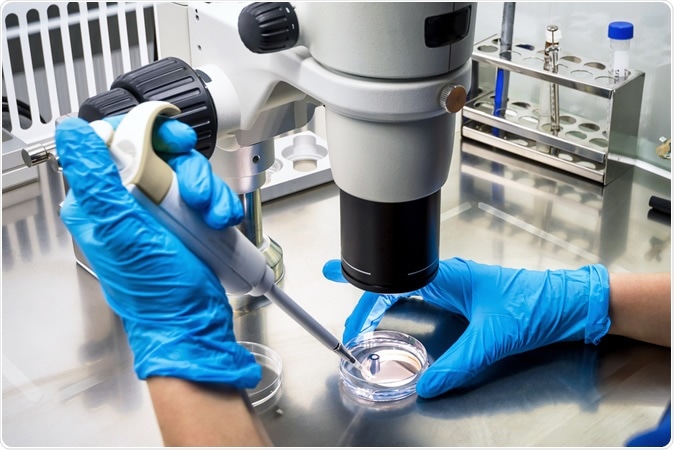A new analysis of cancer drug development by researchers at the Institute of Cancer Research, London, shows that the more revolutionary a new cancer drug is, the longer it takes to reach patients in the UK’s National Health Service healthcare system. In other words, refinements on earlier drugs or drugs which are more conventional in their effects make it to the marketplace faster. The study was published in January 2020 in the journal Drug Discovery Today. It looks access to the drugs for cancer that were approved via the European Medicines Agency (EMA) from 2000 to 2016.

Image Credit: Viacheslav Lopatin / Shutterstock
The researchers put each drug into a different category with respect to innovation – low, medium and high. They defined innovation as being designed to hit a new target or to affect a new mechanism of action, or if the drug was developed to meet a new need that had not been considered before.
Drug licensing period
The researchers found that many more drugs are being licensed for cancer at present, from about 6 a year on average to over 13 a year from 2009 to 2016. Many of these are quite different from earlier therapies in terms of concept and mechanism of action. But the reality is that the time required to complete trials successfully and to get drugs approved is taking longer when it comes to more innovative drugs, from about 13 years in the period 2000 to 2008, to 14 years during 2009 to 2016.
From patent to approval
They found that drugs in the high innovation category took much longer to progress from patent filing to the approved status and into the hands of patients, on average over 3 years longer. This is despite the host of initiatives launched supposedly to encourage fast-track approval of these drugs. In concrete terms, it took an average of 14.3 years, 13.5 years and 11 years for the most innovative, medium-innovation and least innovative drugs, respectively, to reach the market, during the period 2009 to 2016.
From patent to start of phase I trials
This is due primarily to increasingly stringent regulations restricting the process of conducting a clinical trial and on licensing a drug. The duration from patent filing to the initiation of phase I trials went up from a median of 2 years in the earlier period to 3 years in the later period.
From trial to EMA authorization
And finally, after the trial began, EMA authorizations were delayed still further, from 7.7 years at first to about 9 years in the later period. For medium- and low-innovation drugs it was 8.7 years and 6.8 years of waiting, respectively.
From authorization to appraisal
Once EMA authorizations went through, it usually speeded up its appraisal of technology from about 21 months on average to 6.5 months, in the earlier and later periods respectively. However, the appraisal process itself took almost as long throughout both periods, about 16 months or more.
Moreover, highly innovative drugs were not receiving a higher priority for NICE recommendations. Only about 38% of these drugs achieved a positive recommendation vs 53% of moderately innovative and 40% of low-innovation drugs. This trend is likely to change since NICE was previously not appraising technology for some very innovative drugs, but has since said it will appraise all new drugs developed for cancer. The implications of this are that the most potentially useful and revolutionary drugs are not usually put on the fast track in today’s drug approvals regime.
Real-life examples
The findings suggest that the drug discovery and development process in the UK and Europe is probably due for a major overhaul in terms of rewarding greater innovation and effectiveness, since only this can actually achieve a significant step forward in cancer treatment.
The researchers point to several instances of this trend.
- 20 years for the drug mifamurtide from patent filing to NICE approval for the treatment of osteosarcoma
- 22 years of trabectedin for advanced soft tissue carcinoma
- 15 additional months from FDA approval to EMA licensing of olaparib for breast cancer, and NICE appraisal still pending
Implications
Innovative drugs are based on new concepts that arise from advanced understanding of cancers, the way they arise and the way they grow, spread and change. If the vast array of cancers, old and new, that plague humankind today is to be successfully tackled, the development pathway must be smoothened.
Researchers are also pointing out a new and dangerous trend – most of the stakeholders in the process of drug development are becoming more hesitant to take risks, and this is reflected by the firms, the researchers and the regulations as well. However, these novel drugs are probably the key to treating resistant cancers, which is the greatest hurdle facing researchers and clinicians in this field today.
The message
Researcher Paul Workman says, “Our study details the major progress being made against cancer, with the average number of drugs being licensed each year more than doubling over the last decade. But it also makes clear that our regulatory systems are not keeping pace with advances in the science. It is taking longer for new drugs to reach patients and, alarmingly, the delays are longest for the most exciting, innovative treatments, with the greatest potential to transform the lives of patients.”
They feel that their findings should be a wake-up call to the regulatory bodies to make sure clinical trial regulations are streamlined. Simultaneously, they should offer much greater incentives to companies to develop innovative new drugs and manufacture them for consumer use. Says Workman, “We are calling on Government, regulators and industry to together reshape the cancer therapeutics ecosystem, so the best new treatments can progress to patients much more quickly.”
Journal reference:
Eva Sharpe, Richard Hoey, Christina Yap, Paul Workman, From patent to patient: analysing access to innovative cancer drugs, Drug Discovery Today, 2020, https://doi.org/10.1016/j.drudis.2020.01.004